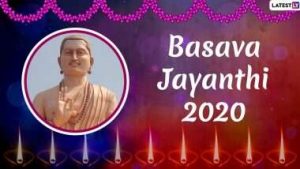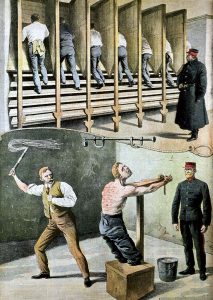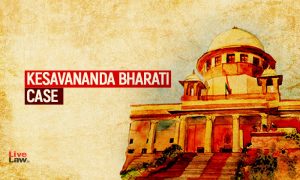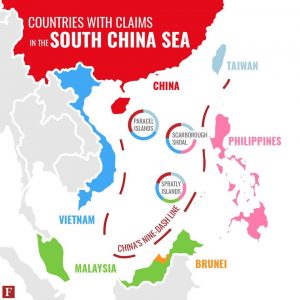Table of Contents
Daily Current Affairs for Government Exams:
Today Current Affairs:27th April 2020 for UPSC IAS exams, State PSC exams, SSC CGL, State SSC, RRB, Railways, Banking Exam & IBPS, etc
Contents:
- Global Basava Jayanthi – 2020
- Flogging (whipping or lashing)
- Basic structure and the Kesavananda Bharati case:
- Comprehensive Nuclear-Test-Ban Treaty
- South China Sea Dispute
- Ozone layer
- The Stockholm International Peace Research Institute (SIPRI) released its report on the military spending of different countries in the world
- Other important current affairs
1. Global Basava Jayanthi – 2020:

Global Basava Jayanthi – 2020 was observed on 26th April digitally.
- Basava Jayanti marks the birth anniversary of Lord Basavanna, the 12th-century poet-philosopher, and the founding saint of the Lingayat faith.
About Basavanna, his thoughts and contributions:
- Basavanna was a 12th-century philosopher, statesman, Kannada poet, and a social reformer during the reign of the Kalachuri-dynasty king Bijjala I in Karnataka,
- Basavanna spread social awareness through his poetry, popularly known as Vachanaas.
- Basavanna rejected gender or social discrimination, superstitions, and rituals.
- He introduced new public institutions such as the Anubhava Mantapa (or, the “hall of spiritual experience”), which welcomed men and women from all socio-economic backgrounds to discuss spiritual and mundane questions of life, in open.
- As a leader, he developed and inspired a new devotional movement named Virashaivas, or “ardent, heroic worshippers of Shiva”.
- This movement shared its roots in the ongoing Tamil Bhakti movement, particularly the Shaiva Nayanars traditions, over the 7th- to 11th-century.
- Basava championed devotional worship that rejected temple worship and rituals led by Brahmins and replaced it with personalized direct worship of Shiva through practices such as individually worn icons and symbols like a small linga.
- Basaveshwara is the first Kannadiga in whose honor a commemorative coin has been minted in recognition of his social reforms.
- In November 2015, the Prime Minister of India Narendra Modi inaugurated the statue of Basaveshwara along the bank of the River Thames at Lambeth in London.
Basavanna and Sharana movement:
- The Sharana movement he presided over attracted people from all castes, and like most strands of the Bhakti movement, produced a corpus of literature, the vachanas, that unveiled the spiritual universe of the Veerashaiva saints.
- The egalitarianism of Basavanna’s Sharana movement was too radical for its times.
- He set up the Anubhava Mandapa, where the Sharanas, drawn from different castes and communities, gathered and engaged in learning and discussions.
- Sharanas challenged the final bastion of the caste order: they organized a wedding where the bridegroom was from a lower caste, and the bride a Brahmin.
3. Flogging (whipping or lashing) :

Recently, Saudi Arabia has abolished flogging (whipping or lashing) as a form of punishment and the death sentence for minors.
- The Islamic kingdom has no codified system of law. The individual judges interpret Islamic law (Sharia) and come up with their own sentences.
Abolition of Flogging as Punishment:
- Before abolition, flogging was mandatory as a form of corporal punishment and could extend to hundreds of lashes.
- Courts ordered it for murder, breach of peace, homosexuality, consumption or possession of alcohol, adultery, and insulting Islam, among others.
Abolition of Death Sentence for Minors:
- It ensures that no-one who committed crimes as minors could receive the death sentence for those crimes.
- Instead, the individual will receive a prison sentence of no longer than 10 years in a juvenile detention facility.
- However, there is a possibility of exception for people who carry out terrorism-related crimes as minors.
- The practice of capital punishment for crimes committed by people under the age of 18 was in contradiction to the United Nations Convention on the Rights of the Child.
- However, the country still practices public executions and other forms of corporal punishment such as amputation for theft. It has been criticized for them as well.
4.Basic structure and the Kesavananda Bharati case:

The concept of ‘basic structure’ came into existence in the landmark judgment in Kesavananda Bharati vs State of Kerala case (1973) 47 years ago.
- Since the adoption of the Indian Constitution, debates have started regarding the power of the Parliament to amend key provisions of the Constitution.
- In the early years of Independence, the Supreme Court conceded absolute power to Parliament in amending the Constitution, as was seen in the verdicts in Shankari Prasad case (1951) and Sajjan Singh case (1965).
- In both cases the court had ruled that the term “law” in Article 13 must be taken to mean rules or regulations made in exercise of ordinary legislative power and not amendments to the Constitution made in exercise of constituent power under Article 368.
- This means Parliament had the power to amend any part of the constitution including Fundamental rights.
- Article 13(2) reads, “The State shall not make any law which takes away or abridges the right conferred by this Part (Part-III) and any law made in contravention of this clause shall, to the extent of the contravention, be void.”
- However, in the Golaknath case (1967), the Supreme Court held that Parliament could not amend Fundamental Rights, and this power would be only with a Constituent Assembly.
- The Court held that an amendment under Article 368 is “law” within the meaning of Article 13 of the Constitution and therefore if an amendment “takes away or abridges” a Fundamental Right conferred by Part III, it is void.
- To get over the judgments of the Supreme Court in the Golaknath case (1967), RC Cooper case (1970), and Madhavrao Scindia case (1970), the then government headed by Prime Minister Indira Gandhi had enacted major amendments to the Constitution (the 24th, 25th, 26th, and 29th).
- All the four amendments brought by the government were challenged in the Kesavananda Bharati case.
Kesavananda Bharati case
- In the Kesavananda Bharati case, relief was sought against the Kerala government vis-à-vis two state land reform laws, which imposed restrictions on the management of the religious property.
- The case was challenged under Article 26, concerning the right to manage religiously owned property without government interference.
- The question underlying the case: Was the power of Parliament to amend the Constitution unlimited? In other words, could Parliament alter, amend, abrogate any part of the Constitution even to the extent of taking away all fundamental rights?
- The Constitutional Bench in Kesavananda Bharati case ruled by a 7-6 verdict that Parliament could amend any part of the Constitution so long as it did not alter or amend the basic structure or essential features of the Constitution.
- However, the court did not define the term ‘basic structure’, and only listed a few principles — federalism, secularism, democracy — as being its part.
5.Comprehensive Nuclear-Test-Ban Treaty:
Recently, the United States State Department has accused China and Russia of conducting nuclear tests with low yields, in violation of the Comprehensive Nuclear-Test-Ban Treaty (CTBT).
- CTBT was negotiated at the Conference on Disarmament in Geneva and adopted by the United Nations General Assembly in 1996.
- The Treaty intends to ban all nuclear explosions – everywhere, by everyone. It was opened for signature in 1996 and since then 182 countries have signed the Treaty, most recently Ghana has ratified the treaty in 2011.
- A comprehensive test ban has been defined as a “zero yield” test ban that would prohibit supercritical hydro-nuclear tests but not sub-critical hydrodynamic nuclear tests.
- Hydronuclear tests study nuclear materials under the conditions of explosive shock compression.
- Their yield ranges from negligible all the way up to a substantial fraction of full weapon.
- Subcritical (or cold) tests are types of tests involving nuclear materials and possibly high-explosives that purposely result in no yield.
- The Treaty will enter into force after all 44 States listed in Annex 2 to the Treaty will ratify it.
- These States had nuclear facilities at the time the Treaty was negotiated and adopted.
As of August 2011, 36 of these States have ratified the Treaty. - Eight states still need to do so: China, North Korea, Egypt, India, Iran, Israel, Pakistan, and the United States.
India, North Korea, and Pakistan have not yet signed the Treaty.
6.South China Sea Dispute:

Recently, China unilaterally renamed 80 islands, reefs, and other geographical features around the Spratly and Paracel Islands (in the South China Sea) with Chinese names, drawing criticism from neighboring countries who have also laid claim to the same territory.
Spratly Islands dispute:
- There has been an ongoing territorial dispute between China, Taiwan, Vietnam, the Philippines, and Malaysia concerning the ownership of the Spratly Islands archipelago and nearby geographical features like corals reefs, cats, etc. in the South China Sea.
- Although the Spratly Islands are largely uninhabited, there is a possibility that they may have large reserves of untapped natural resources including Oil.
Paracel Islands dispute:
- The Paracel Islands archipelago is a collection of 130 islands and coral reefs and is located in the South China Sea, almost equidistant from China and Vietnam.
- Since 2012, China, Taiwan, and Vietnam have attempted to reinforce their claims on the territory by engaging in the construction of government administrative buildings, tourism, land reclamation initiatives, and by establishing and expanding military presence on the archipelago.
7.Ozone layer :

The C3S (Copernicus Climate Change Service) and CAMS (Copernicus Atmosphere Monitoring Service) confirmed that the hole in the Ozone layer has healed itself.
- The hole was 1 million square kilometers wide above the Arctic. The hole was identified by scientists in March 2020.
- It was formed due to unusual climatic conditions.
- The main reason for the hole to heal by itself is the polar vortex. Also, according to the scientists, the closure of the hole is not due to the reduced pollution levels due to COVID-19 lockdown
- The hole possessed greater threats. It was the largest pole that was found in the history of the Ozone layer. If the hole had moved towards the south, it would have created catastrophic results in the mid-latitudes.
- The Polar Vortex is a winter phenomenon.
- Polar Vortex is cyclonic circular winds that blow in the stratosphere from west to east. Polar Vortex extends from tropopause through the stratosphere and into the mesosphere.
- When the vorticity is high, the values of ozone are minimum and the temperature is at its highest cold.
- Thus, the hole has closed as the vorticity has decreased.
8. The Stockholm International Peace Research Institute (SIPRI) released its report on the military spending of different countries in the world

- The Stockholm International Peace Research Institute (SIPRI) released its report on the military spending of different countries in the world. According to the report, the US, China, and India are the three topmost military spenders in 2019.
- Following the three top military spenders in the world, Russia and Saudi Arabia were in the fourth and fifth places respectively.
- The top three military spenders accounted for 62% of the world’s military expenditure.
- However, it is the first time in the history of the report that 2 Asian countries have occupied the top positions.
- The total military expenditure increased by 3.6% in 2019 as compared to 2018.
- In 2019, the global expenditure spent was 2 trillion USD.
- This is the highest expenditure spent since the 2008 global financial crisis.
- According to the report, the military expenditure of India increased due to its increasing tensions with Pakistan over the Kashmir issue. In 2019, India has spent 71.1 billion USD on its military.
- This has increased by 6.8% as compared to 2018.
Other important current affairs:
1. A report by the non-profit Centre for Science and Environment (CSE) has found that two key mining districts, Keonjhar in Odisha and Anuppur in Madhya Pradesh (MP), have opened creches for the children of their inhabitants by using the District Mineral Foundation (DMF) funds.
- Keonjhar, the biggest producer of iron ore, has the highest DMF accrual across the country.
- Both the mining districts through the creches are attempting to target malnutrition among pre-Anganwadi children through local engagement.
- Creches are being executed through an expert local non-profit that looks at community participation, particularly recruiting local women as creche workers.
- The focus is on meeting the dietary requirement of children between 0-3 years.
- Both districts are also working on monitoring the nutritional gains made by the children in cheches as evidence for the intervention.
2. Recently, Australia has informed India that the exercise Pitch Black 2020, scheduled to be held from 27th July to 14th August has been canceled due to the Covid-19.
- The next edition will be held in 2022.
- Exercise Pitch Black is a biennial three-week multilateral air combat training exercise hosted by the Royal Australian Air Force (RAAF).
- Its last edition was held in 2018.
- It ensures that the training and integration of forces that occur during this exercise directly support the Air Force’s ability to conduct operations.
3. United States President Donald Trump announced that he would be using an executive order to suspend legal immigration into the U.S. for 60 days. The time limit could be extended depending on conditions on the ground.
- The immediate context of his proposal is the teetering U.S. economy, which has ground to a virtual halt in the face of the pandemic.
- The deeper context to the announcement is the fact that Mr. Trump is seeking re-election in the November 2020 election. Proposals to restrict immigration served Mr. Trump’s campaign well during the 2016 presidential election.
4. The COVID-19 pandemic may earn Governor’s rule for the Bodoland Territorial Area Districts (BTAD) in Assam.
- The State’s Governor is the constitutional head of the BTAD that falls under the Sixth Schedule of the Constitution and is administered by the Bodoland Territorial Council (BTC).
- Elections were scheduled to be held for the BTC on April 4 but were deferred indefinitely in view of the pandemic. The council’s current term expires on April 27.
- As per the Sixth Schedule, the four states viz. Assam, Meghalaya, Tripura, and Mizoram contain the Tribal Areas which are technically different from the Scheduled Areas.
- Though these areas fall within the executive authority of the state, provision has been made for the creation of the District Councils and regional councils for the exercise of certain legislative and judicial powers.
- Each district is an autonomous district and the Governor can modify/divide the boundaries of the said Tribal areas by notification.
6. NTPC Ltd, India’s largest power producer and a central PSU under the Ministry of Power has invited Global Expression of Interest (EoI) to provide 10 Hydrogen Fuel Cell (FC) based electric buses and an equal number of Hydrogen Fuel Cell-based electric cars in Leh and Delhi.
- The move to procure Hydrogen Fuel Cell-based vehicles is first of its kind project in the country, wherein a complete solution from green energy to the fuel cell vehicle would be developed.
- Hydrogen is the lightest and first element on the periodic table. Since the weight of hydrogen is less than air, it rises in the atmosphere and is therefore rarely found in its pure form, H2.
- At standard temperature and pressure, hydrogen is a nontoxic, nonmetallic, odorless, tasteless, colorless, and highly combustible diatomic gas.
- Hydrogen fuel is a zero-emission fuel burned with oxygen. It can be used in fuel cells or internal combustion engines. It is also used as a fuel for spacecraft propulsion.
7. Recently, India has decided to fill its strategic petroleum reserves in view of the slump in crude prices.
- This will help on two fronts: India will get cheap oil for its reserves and it will also help in resolving the storage problem for refiners.
- Strategic petroleum reserves are huge stockpiles of crude oil to deal with any crude oil-related crisis like the risk of supply disruption from natural disasters, war or other calamities.
- According to the agreement on an International Energy Programme (I.E.P.), each International Energy Agency (IEA) country has an obligation to hold emergency oil stocks equivalent to at least 90 days of net oil imports.
- In case of a severe oil supply disruption, IEA members may decide to release these stocks to the market as part of collective action.
- India became an associate member of the International Energy Agency in 2017.
8. CERT-In (the Indian Computer Emergency Response Team) is a government-mandated information technology (IT) security organization. CERT-In was created by the Indian Department of Information Technology in 2004 and operates under the auspices of that department.
- The purpose of CERT-In is to respond to computer security incidents, report on vulnerabilities, and promote effective IT security practices throughout the country.
- According to the provisions of the Information Technology Amendment Act 2008, CERT-In is responsible for overseeing the administration of the Act.




